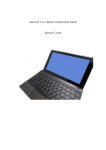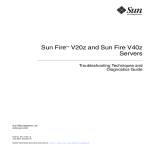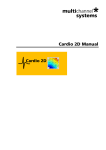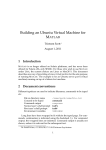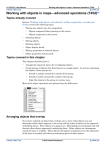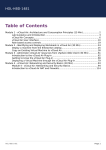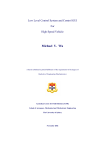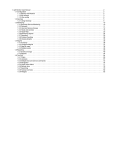Download vSphere 5 AutoLab
Transcript
vSphere 5 AutoLab V 1.0a www.labguides.com Your lab on your laptop Table of Contents vSphere 5 AutoLab.................................................................................................................................................. 3 Acknowledgements ................................................................................................................................................ 4 Lab platform ........................................................................................................................................................... 5 VMware Workstation Setup ............................................................................................................................... 6 VMware ESXiSetup ............................................................................................................................................. 7 Deploy on ESXi .................................................................................................................................................... 7 VMware Fusion Setup ......................................................................................................................................... 9 VMware Player Setup ....................................................................................................................................... 12 The Virtual Machines ............................................................................................................................................ 13 Build the Lab ......................................................................................................................................................... 14 Task 1 – Prepare the prebuilt VMs ................................................................................................................... 14 Task 2 – Build DC, Windows Infrastructure ...................................................................................................... 15 Task 3 – Build VC, vCentre ................................................................................................................................ 17 Task 4 – Build ESX servers ................................................................................................................................. 19 Task 5 – Populate vCentre ................................................................................................................................ 20 Task 6 - Add vSphere Management Assistant .................................................................................................. 20 Lab Build Time ...................................................................................................................................................... 21 Shutting the lab down .......................................................................................................................................... 21 Accessing the built lab .......................................................................................................................................... 22 As Built Documentation ........................................................................................................................................ 23 IP Addressing .................................................................................................................................................... 23 UserIDs.............................................................................................................................................................. 24 Host Network .................................................................................................................................................... 24 Host and Shared Storage .................................................................................................................................. 24 Rebuild Process..................................................................................................................................................... 25 Veeam ONE Installation ........................................................................................................................................ 26 Veeam Backup & Replication installation ............................................................................................................. 37 VMware View Installation .................................................................................................................................... 41 VMware vCloud Director Installation ................................................................................................................... 42 Troubleshooting ................................................................................................................................................... 46 AutoLab Changes and Futures .............................................................................................................................. 49 2 vSphere 5 AutoLab This lab builder kit is designed to produce a nested vSphere 5.0 or 4.1 lab environment with the minimum effort. Prebuilt shell VMs are provided along with automation for the installation of operating systems and applications into these VMs. The lab build was originally created to aid study towards VCP5 certification however it has many other possible uses. In the future VMware View and SRM will be added to the build and automation. The project lives at www.labguides.com and updates will occur there. Details of the insides of the AutoLab will be published at www.Professionalvmware.com as time allows. These instructions are not intended for the absolute beginner. They will allow someone with moderate server infrastructure knowledge to rapidly build a vSphere lab. The AutoLab has grown to allow evaluation and testing of additional software, Veeam management and backup software, VMware View and VMware vCloud director. About Me I’m Alastair Cooke, I live in New Zealand and work as a trainer, consultant and writer for my own company Demitasse. I host the APAC Virtualization Podcast to help build a community with a focus around the region I work in and also host the APAC edition of the Professional VMware BrownBag podcast. This is version 1.0, a fair amount of testing has been done, but there will be things that don’t work in your environment as they do in mine, please let me know how you find the AutoLab and what needs improving or adding.You can email Nick and I through [email protected] 3 Acknowledgements This project would not have come to the world without the contributions of numerous others. First of all my Wife, without whom I wouldn’t be where I am and who is very understanding of my need to do this work despite it giving it away for free. Thanks Tracey. Nick Marshall www.virtualnetworkdesign.com Another project with Nick led to this project. His testing and QA on the lab build through its various stages were invaluable. Damian Karlson damiankarlson.com for adding vCloud Director to the AutoLab James Bowling www.vsential.com for documenting the full Fusion setup for the AutoLab Veeam Aside from producing some great software that supports virtualization and then giving plenty of it away for free Veeam is also sponsoring the AutoLab, making it much easier for us to develop new versions that support more products. FreeNAS The storage platform for the lab. Having an open source storage option makes the lab possible. This lab uses version 0.72 for its smaller memory footprint, for more serious use version 0.8 looks well suited. FreeSCO The router on a floppy. Another open source project that does great things and asks little in return. JouninTFTPd More free software, this time the file transfer tool of the PXE environment used to build the ESXi servers. VMware for having such a great virtualization platform. I was amazed how much less resource the lab takes to run on ESXi than VMware Workstation. Microsoft for providing the operating system we most often need to virtualize. Labguides.com forum moderators, help you through issues another example of community helping community. This is the beta test crew, the ProfessionalVMware vBrownBag team as well as some Kiwi and Australian helpers. Cody Bunch ProfessionalVMware.com David Manconi Damian Karlson damiankarlson.com Grant Orchard Josh Atwell www.vtesseract.com Tim Gleed Michael Webster longwhiteclouds.com 4 Lab platform Required Hardware The core lab can run on a single PC, a dual core 64bit CPU and a minimum of 8GB RAM is required, along with around 100GB of free disk space. This is the minimum, more RAM and a newer CPU will help a lot especially if you need to keep the lab running and use the PC for other things. An i7 CPU, 16GB of RAM and an SSD (120GB+) will all make the lab host machine more responsive and reduce the amount of waiting during labs. To make the labs as available as possible we have designed a configuration that will work with a less capable host. The lab was developed on a laptop purchased in 2009 and upgraded to 8GB of RAM, a large SSD and a second hard disk. Running the lab VMs off the SSD makes a big difference to the usability of the lab; it has also prevented me wanting to replace my old laptop. As the AutoLab has grown there are parts that extend beyond vSphere, these components will require more RAM or for one of the ESXi hosts to be shut down to make RAM available. Running the labs under ESXi does allow more efficient use of RAM, but requires a second PC to manage from. As another option you may choose to allow VMware Workstation to swap some VM RAM, for me this makes performance intolerable but others have had good results Lab Virtualization Platform All of the elements of the lab were developed in virtual machines under VMware Workstation v8, this version of workstation fully supports running ESX server in a virtual machine on suitable hardware. The labs can also be run under VMware Player as well as VMware Fusion and even VMware ESXi 5.0, this document is based on deployment on VMware Workstation or ESXi. Additional software In addition to the AutoLab kit, lab host and its virtualization software you will need a few other pieces of software, below is a list with download links where these are freely available. For the older vSphere versions and for PowerCLI you will need an account with VMware or a good contact at VMware or a VMware partner. The version 4.1 components are only required if you plan to build a 4.1 environment, usually so you can run the upgrade to 5.0. vCenter 5.0 Install DVD ESXi 5.0 Install CDROM VMware PowerCLI installer VMware vSphere CLI Installer Microsoft Windows Server 2008 R2 180 day trial DVD Microsoft Windows 2003 Server 32bit CDROM vCenter 4.1 Install DVD ESXi 4.1 Install CDROM ESX 4.1 Install CDROM View 5.0 or 5.1 vCloud and vShield installers Veeam ONE and Veeam Backup & Replication installers 5 VMware Workstation Setup The Workstation build is designed to work with a host with 8GB of RAM and VMware workstation version 8.0. The host operating system must be 64bit and all the CPU virtualization features must be enabled in the BIOS in order to be able to run the 64bit VMs. Placing the lab files on a fast disk and having a host with more RAM will make the lab run faster. The main setup required is to reserve 7168MB of RAM for VMs and choose to Fit all virtual machine memory into reserved host RAM. Both of these settings are under the Edit menu Preferences… item. If your lab host has more than 8GB of RAM select a larger value and allocate more RAM to the VMs. The other requirement is that the Lab network be configured. Under the Edit menu is the Virtual Network Editor. Select the VMNet3 object; make sure Host Only is selected in VMNet Information and that Use Local DHCP Service to distribute IP addresses to VMs is not selected. The Subnet IP should be 192.168.199.0 with a Subnet Mask of 255.255.255.0. You may use the option Connect a host network adapter to this network to allow your PC direct access to the lab network, otherwise all your network access will be through the router VM. Unless you are going to run multiple copies of the lab, each on a different VMNet but the same IP range, then it is easiest to have the host connect to the network. 6 VMware ESXiSetup The lab runs extremely well under ESXi, in my lab it consumes a peak of 4.5GB of RAM during build and about 40GB of disk space, although 220GB is allocated. A higher performance disk system also reduces the lab build time as this is mainly disk IOPS constrained. The lab will usually use a portgroup on an Internal Only Standard vSwitch, i.e. one with no physical NICs attached. The default portgroup name is Lab_Local and this portgroup must be setup to allow Promiscuous mode and must be on VLAN ID 4095. When the vApp is imported you may choose to use a different portgroup for each vApp, the portgroups should be on their own vSwitch to avoid conflicts.Your ESXi server should also have a VMkernel port on this network, IP 192.168.199.99, this will allow access to the Build share on the NAS VM. The router VM also connects to your main network, the default configuration calls this network External. To enable the nested ESXi servers to run 64bit VMs your outer ESXi server needs to pass the Intel VT or AMD V feature into the VMs. Open a command prompt on your ESXi server, either through SSH or on the local console, and type the following command echo 'vhv.allow = "TRUE"' >> /etc/vmware/config Deploy on ESXi The lab is distributed as a single ova file, this contains the NAS VM. Deploy the ova and power on the Lab_NAS VM. Once the NAS has booted create a new NFS datastore pointing to the Build share, server 192.168.199.7 and Folder /mnt/LABVOL/Build as shown below 7 Once the datastore is created use the vSphere Client datastore browser and browse to \Automate\ShellVMs where you will find the remaining lab VM folders. The VMs must not be run from this location as they won't perform well and the datastore will quickly run out of space. If you have vCenter then register each VM then migrate it to its proper datastore. Do not power the VMs up on the Lab_NFS datastore as it will perform poorly and then run out of space. If you do not have vCenter you will need to use the datastore browser to copy the VMs from the Lab_NFS datastore before registering the VMs. The copy takes quite a while as it appears not to respect the thin provisioned disks. Finally the VMs need to have their CDROM and floppy drives attached to media images. You may need to copy the boot floppy images from the Build share, in \Automate\BootFloppies to another datastore. The floppy images match the VM names, apart from vCloud which doesn't need a floppy. 8 VMware Fusion Setup Huge thanks to James Bowling @vSential for documenting the whole Fusion setup process. The Fusion build is designed to work with a host with 8GB of RAM and VMware Fusion version 4.0. The host operating system must be 64bit and all the CPU virtualization features must be enabled in the BIOS in order to be able to run the 64bit VMs. Placing the lab files on a fast disk and having a host with more RAM will make the lab run faster. The other requirement is that the Lab network be configured. Unlike the VMware Workstation setup, configuring the network is not available within the VMware Fusion settings. To create the required network we will open Nick Weaver’s UBER Network Fuser (UNF), as seen here: Make sure that you have VMware Fusion stopped as you will not be able to make any changes to anything within UNF. Once you have UNF open select the Networks section where you will be presented with a list of two networks, Default Host Only and Default NAT. Click on the ‘+’ to add a new network. Change the name of the network to VMnet3 and hit enter. One thing you will notice is that the subnet has been selected at random. Don’t worry…this is by design. We will fix this in a minute. Before we do that, you will want to set DHCP and NAT to off, then set Virtual Adapter to on, like so: 9 Next we will actually change the subnet. To do this, open a terminal and do the following: cd /Library/Preferences/VMware\ Fusion Now we need to open the file “networking” in an editor, I typically just use vi but use whatever editor you are comfortable with. You will want to change the VNET_X_HOST_ONLY_SUBNET to reflect the required 192.168.199.0. See the screenshot if you are unsure: Once you make the change save the file and go on to the next step in deploying the AutoLab. Don’t misplace UNF as you will need it again after we place the VMs in the appropriate place!!!! Placement of AutoLab Virtual Machines In the typical VMware Workstation setup you could potentially place the VMs anywhere on your machine. To simplify the configuration in VMware Fusion and use with UBER Network Fuser (UNF) we will place the VMs in the default VMware Fusion Virtual Machines directory. This is typically: HD -> Users -> username -> Documents -> Virtual Machines Simply copy all of the folders from the extracted AutoLab zip file into the above directory. Wait…you aren’t done just yet. VMware Fusion creates virtual machines in directories that are named like so: esxi.example.vmwarevm 10 If you notice it uses an extension of “.vmwarevm” to allow the association with VMware Fusion and this is the only way UNF will be able to see the VMs. Go ahead and rename each folder to: CS1.vmwarevm CS2.vmwarevm DC.vmwarevm Host1.vmwarevm Host2.vmwarevm NAS.vmwarevm Router.vmwarevm SS.vmwarevm V1.vmwarevm VBR.vmwarevm VC.vmwarevm vCloud.vmwarevm Now that we have renamed all of the folders we need to open UNF again so we can associate our VMnet3 network that we created at the beginning with each vmnic on each VM. This is simple but needs to be done on each VM and each vmnic. Once you have opened UNF, click on Configuration. Make sure that your paths are set appropriately, if they are not then correct them. Next click on “Virtual Machines”, you should see a list of virtual machines now. If you don’t, hit Refresh VMs and it should populate. Select one of the VMs in the list and you can change the network tied to that vmnic by clicking on the vmnic. Do that for each VM and each interface that needs to be tied to the new network. Once this is complete you can go ahead and move on to the typical steps taken for deploying the AutoLab. I hope this helps all of the Mac users out there! 11 VMware Player Setup I also don’t have a PC that could run the lab and doesn’t have Workstation installed. The Workstation VMs should be fine, but like Fusion the network editor isn’t there. A quick Google showed the answer. Luckily it looks like it’s included in the installer but not installed by default. If the above link fails then Google for VMware player "Virtual network editor" 12 The Virtual Machines The VMs in the download package are configured to be able to be powered on under VMware Workstation configured to required VMs to run entirely from reserved RAM and allocating 7GB of RAM for these VMs. The Windows VMs will be heavily overcommitted in the guest OS however this provides better VM performance than allowing VMware Workstation to page these VMs out to a hard disk. If you have sufficient RAM you can increase the allocation to the VMs or allow VMware Workstation to swap some RAM. Unless you have a lot of RAM in your lab host you are unlikely to be able to run everything at the same time. Name DC VC NAS Router Host1 Host2 VMA V1 VBR CS1 CS2 SS vCloud Group Core Core Core Core Core Core Veeam Veeam View View View vCloud Function Domain Controller Virtual Centre Shared Storage In and outbound access ESXi Server ESXi Server Command line management Veeam ONE Veeam Backup & Replication Connection Server 1 Connection Server 2 Security Server vCloud Director Min. RAM 384MB 1.25GB 128MB 12MB 2GB 2GB 128MB 1GB 1GB 1GB 1GB 512MB 1.5GB Ideal RAM 1GB 2.5GB 512MB 16MB 4GB 4GB 600MB 2GB 2GB 2GB 2GB 1 GBB 3 GB With all the lab VMs running at their minimum RAM my AutoLab build host uses just under 16GB of RAM, more RAM may be required to run a full vCloud environment at the same time as View. 13 Build the Lab These steps use the full set of automation to build a complete lab environment. The steps should be completed in order and each step allowed to complete before starting the next step. If you are building the lab to train on then you may want to use the minimum automation and manually complete steps. Task 1 – Prepare the prebuilt VMs Extract the vSphere AutoLab archive to a folder and open all the VMs with VMware Workstation or Fusion. When you power on each VM you will be asked whether you moved or copied the VM. Always answer “I copied it” for these VMs, this way a new UUID and MAC address is assigned for each VM and makes running multiple isolated copies of the lab possible. Power on the Router VM, wait for it to boot to the logon prompt. The router published the windows share “Build” from the NAS through its external interface; this is the IP address at the end of the line “Waiting for DHCPOFFER on eth0”. This is useful if you don’t have a PC connected to the Lab network such as deploying a lab on ESX. Power on the NAS VM, wait for it to boot to the logon prompt If your PC has an IP address on the VMNet3 network, it is usually 192.168.199.1. Ping 192.168.199.7 which is the NAS, if this succeeds open the window share \\192.168.199.7\Build.If the ping fails then you can access though the NAS using the external IP address of the router. In the example above the external address is 192.168.20.118 (it’s on the Waiting for DHCPOFFER on eth0 line) so the share is \\192.168.20.118\Build. In the share is the file ReadMe.html. Open this with a web browser and follow the directions to populate the Build share. Much of the software here is licensed so cannot be distributed with the AutoLab kit, it’s also large! I keep the collection in a folder on my PC and simply copy it in when I’m setting up a new lab. 14 If you watch the console of the NAS VM you may see messages about not having enough RAM for ZFS, this does not cause any issues and can be ignored In the Automate folder you will find Automate.ini. This file allows even more automation but is mostly for my use. The VCInstall, BuildDatastores, BuildVM and Product Key lines answer the questions in the VC server build and Add Hosts scripts. The TZ line allows the automatic setting of the Time Zone in the Windows VMs, it uses the TZUtil command, to get the right text for this run “tzutil /g” on your PC and paste the result in place of my time zone. The View section allows the automation of the View connection servers and security server along with the setup of the nested Windows XP VM that can be used as a desktop for View. There are some additional actions required for View so check the section later in this document. Do not move on to Task 2 until the build share is fully populated. Task 2 – Build DC, Windows Infrastructure On both the VC and DC VMs make sure the CDROM drive is connected to a Windows Server 2008 R2 install ISO, connected at power on is recommended. Also make sure that the right floppy image is connected, boot floppy images can be found on the build share in \Automate\BootFloppies. The boot floppies only work with Windows 2008R2 SP1 ISO files, using the RTM ISO (no service pack) will result in a failed install Power on the DC VM to start the unattended install.The first time you boot this VM it has a blank hard disk, so it will boot from the Windows installer CD and begin the build process. On subsequent reboots the installer will pass boot over to the hard disk unless you press a key, pressing a key at this prompt will completely rebuild the VM with no confirmation. 15 The VM will boot from the Windows Server 2008 R2 CDROM and use “autounattend.xml” file on the floppy disk image to automate the Windows install. This will take some time, go talk to your family for a while, or read some documentation to pass the time. On my laptop this takes around an hour. No input will be required from you through this process and you cannot start the other installs until it is complete. After installing AD the VM will restart and install SQL Express and setup the PXE environment followed by installing the VMware tools. If these steps fail or don’t start make sure your NAS VM is running and that you setup the Build share as outlined in task 1. 16 After the entire automated install completes the VM will reboot a final time, returning to the desktop as autologon is setup. At this point the Domain Controller is setup and ready. If the PowerShell shortcut is missing from the desktop then the build may not be complete, check with the build log in c:\Buildlog.txt. There is also a troubleshooting section at the end of this guide. There is a script to test that the build has completed successfully, and that the Build share was correctly populated. Open the Validate script as administrator by right clicking on the Validate shortcut on the desktop and selectingOpen as Administrator. As you would expect green is good, yellow is OK, red not so good. If the build share is not correctly populated (apart from the Windows Installer floppy) then the DC VM will need rebuilding as most software installers come from the build share. There is a log of the build in c:\Buildlog.txt which may help; the BuildLog shortcut on the desktop opens this file. Once the Validate script completes with green you are ready for task 3. Task 3 – Build VC, vCentre This process begins the same as the DC build, attach the ISO and appropriate floppy. Then boot from the Windows install disk, the floppy contains the “autounattend.xml” file. Part way through you must choose how much automation you want. 17 Power on the VC VM and allow it to boot from the CD, as with the DC VM booting from the CD will always rebuild without any prompt. After about 20 minutes you will be offered vCenter install automation. If you don’t need to practise the vCentre installs go ahead and use the automation for the vSphere version you want, 4 or 5. If you just want to manually install the vSphere components press B and if all you’d like automated is the install of the VMware Tools press N. When the automation completes the VM will be left logged on and configured with Autologon for your convenience. There are a few scripts that can be run on the VC; they are wrapped up in the Script Menu script on the desktop. The menu script does not require elevated privileges but some of the other scripts will prompt for permission to elevate when they are launched. The same validate script that ran on the DC can be run on the vCenter server to validate it’s build and there is a build log in C:\Buildlog.txt, both are available in the Script Menu 18 The basic VC build does not include a default gateway, to prevent needless VUM downloads when you rebuild repeatedly. To access the Internet from the VC or to access the VC via the Router from your external network, you will need to run the Add Route option from the script menu. It may take a few minutes after you are able to login before all the services are started, be patient as the “VMware VirtualCenter Management Webservice” can take a few minutes to start. The desktop shortcut named vSphere launches the vSphere client and automatically logs into VC as the current logged on desktop user. PuTTY has pre-configured configurations for accessing the ESXi hosts and VMA, if you deploy the VMA. Task 4 – Build ESX servers Power on the ESX VMs one at a time; wait for the build to complete on each one before starting the build on the next. If you plan to build as ESX 4.1 then change the OS type on the VMs to reflect this and increase the RAM allocation for host1 to 2.25GB to allow HA to configure successfully. When the VMs boot they will use PXE to load a menu from the DC, choose the option for the ESXi version and server you wish to install.The automated installs build with the standard IP addresses and no post build customization. After the build your ESX server will be ready 19 Build the second server as required. Confirm that both ESX servers have the correct static IP addresses before moving to the next stage. Task 5 – Populate vCentre To automatically add the ESXi servers to vCenter, setup an HA and DRS cluster as well as networking and datastores on the ESXi servers use the “Add newly build hosts…” option from the script menu. The script will execute with a minimal amount of feedback, some yellow warning messages are usual, red means something has gone wrong. During the process CPU saturates on my lab host. You may choose to have the script create datastores on the three iSCSI LUNs, if the ESXi servers already see datastores then any VMs on the datastores will be added to the inventory. You may choose whether to have the script create and power on a first VM, this VM will boot from the WinInstall.iso on the build share and use the unattend.txt file that is in the WinInstall.flp file. You will be asked for a Windows Product Key for the Guest OS Customization Specification, enter a key that corresponds to the operating system in your WinInstall.iso file that you placed on the Build share.VMware tools will be automatically installed, along with .Net 3.5 and the Load Storm CPU and Memory load generator. If you entered options in the B:\Automate\automate.ini file then these options will be taken rather than asking you. Task 6 - Add vSphere Management Assistant The vSphere Management Assistant (VMA) virtual appliance is not included with the AutoLab kit as it is large and is not applicable to all uses of the lab. If you are studying for the VCAP5-DCA exam or need a VMA for other purposes then you can add one to the lab. When you have imported the .ovf file edit the VM to use the VMNet3 network and 128MB of RAM. When you start the VMA appliance assign the IP address of 192.168.199.6 and set a password, unfortunately you will not be able to use the lab default password, I use “VMw@re1!”. 20 Lab Build Time This table gives an indication of the time to build a core vSphere lab Time 0:00 0:15 1:15 1:30 2:00 2:15 2:30 3:00 Action Power on NAS and copy in contents of Build share Power on VC VM, build automated DC built Power on VC VM, Windows build Select vCentre 5 automated build VC Built Power on Host1 and select ESXi 5 build Host1 built Power on Host2 and select ESXi 5 build Host2 built Run AddHosts script Cluster Built Datastores built and first VM installing operating system Shutting the lab down Since the lab takes up so much of the resources on a PC you will probably want to shut it down when you’re not actively working on it. TheShutdown Lab shortcut on the VC desktop runs a PowerShell script which will quickly shutdown everything except the NAS and Router VMs, these VMs can be shutdown using VMware Workstation power control. 21 Accessing the built lab While the VMware Workstation console is perfectly functional you may wish to use guest OS native tools, like RDP. If your PC has an IP address on the lab subnet then you may use these directly. Alternatively the Router VM provides access to the lab from its external IP address. Some access to the lab is published through the router. In the example below the external IP address of the router is 192.168.20.199, I use a DHCP reservation and a fixed MAC address on my router VMto keep this consistent in my lab. Windows sharing from the NAS VM is published on the normal ports so you can access the Build share through the routers external IP address. The management web interface of the NAS VM is available on the standard HTTP port 80 of the router’s external IP address. The VC VM is available via RDP on the external IP address of the router using the default RDP port of 3389. The DC VM is available via RDP on the external IP address of the router using port 3388. The router also provides access to SSH access to the ESXi servers and VMA, this allows PuTTY or another SSH client to connect to these VMs from your external network. Server Host1 Host2 VMA External port 122 222 22 The management interface of the Router is the main thing that cannot be accessed from the external network; this is athttp://192.168.199.2:82 on the internal network. 22 As Built Documentation IP Addressing Main network, no VLAN Subnet Subnet Mask Gateway DHCP server DNS Zone DHCP Scope Purpose Host PC Router (gateway) Domain Controller vCentre server vCentre Management Appliance FreeNAS Host1 Management Host2 Management View Connection Server 1 View Connection Server 2 View Security Server Veeam ONE server Veeam Backup & Replication Server vCloud Director vCloud Proxy vShield Manager Internal Network VLAN ID Subnet Subnet Mask Host1 VMotion Host2 VMotion Host1 FT Logging Host2 FT Logging Host2 as ESX 4.1 Service Console for HA Heartbeat IP Storage Network VLAN ID Subnet Subnet Mask Host1 IPStore 1 Host2 IPStore 1 Host1 IPStore 2 Host2 IPStore 2 192.168.199.0 255.255.255.0 192.168.199.2 192.168.199.4 lab.local 192.168.199.100 – 192.168.199.199 DNS name IP Address 192.168.199.1 gw 192.168.199.2 dc 192.168.199.4 vc 192.168.199.5 vma 192.168.199.6 nas 192.168.199.7 host1 192.168.199.11 host2 192.168.199.12 cs1 192.168.199.33 cs2 192.168.199.34 ss 192.168.199.35 v1 192.168.199.36 vbr 192.168.199.37 vcd 192.168.199.38 vcd-proxy 192.168.199.39 vshield 192.168.199.40 16 172.16.199.0 255.255.255.0 172.16.199.11 172.16.199.12 172.16.199.21 172.16.199.22 172.16.199.42 17 172.17.199.0 255.255.255.0 172.17.199.11 172.17.199.12 172.17.199.21 172.17.199.22 23 UserIDs System Lab.local domain Lab.local domain Router administration NAS Windows VMs VMA vCloud UserID Administrator vi-admin admin admin Administrator vi-admin Root Password VMware1! VMware1! VMware1! VMware1! VMware1! VMw@re1! VMware1! Host Network vMotion and Management Network VMkernel ports have symmetric NIC teaming on VMNic0 and VMNic1, each active on one and standby on the other. Both ports are enabled for Management traffic to provide redundant HA heart beating. There is no routing between the VLANs/subnets; the default gateway for the ESXi servers is on the 192.168.199.0 subnet. Host and Shared Storage ISCSI port binding is not implemented, nor is the NIC teaming configuration required for port binding. ISCSI traffic uses the VMkernel ports on VLAN17. 24 Rebuild Process Open Source Infrastructure The NAS VM should not require rebuilding, nor should the router. If either of these machines requires rebuild then you should probably redeploy the entire lab kit. Windows Servers The DC VM should only require rebuilding to renew licensing. If you are using a 180 day trial license then it will require rebuilding every 180 days. Rebuilding the DC VM simply requires a reboot that is interrupted at the “Press and key to boot from the CD” stage. Rebuilding the DC VM will require the rest of the lab to be rebuilt. The VC VM will be rebuilt more frequently, to change vCentre versions or simply to refresh the lab setup. Rebuilding the VC VM simply requires a reboot that is interrupted at the “Press and key to boot from the CD” stage. If you rebuilt vCenter but not the ESXi servers then use the Script Menu option Add previously configured hosts… to add the hosts back to the vCenter without reconfiguring them. ESXi Hosts The ESX servers can be rebuilt by choosing a build option from the PXE boot menu rather than letting the timer expire. If you are rebuilding the ESXi hosts and not vCenter then delete the cluster from the inventory before running the AddHosts script. The script will skip creating datastores and the WinTemplate VM if they already exist, WinTemplate will be added to the inventory as a VM or Template if it’s found in the location where the script creates it. Concurrent Rebuilds If your Lab platform has sufficient resources it is possible to concurrently rebuild the ESXi VMs, potentially while rebuilding the VC VM. The DC and NAS VMs must be built and operational for the other VMs to rebuild. Usually disk and CPU are the limiting resource for rebuilds. An SSD to store the VMs on and a Quad Core CPU will help here. 25 Veeam ONE Installation Like most management tools Veeam ONE uses a client server model. We will use a dedicated VM named V1 as the server. The environment is more interesting if there are a few nested VMs running and if there is some load in the VMs. Server component install on V1 1. Build the V1 VM, this follows the usual boot from CDROM with floppy attached method used for all the Lab Windows VMs. You should have the basic AutoLab setup built with DC, VC and two ESXi servers. On an a Workstation environment with 8GB of RAM you will need to shut down one of the ESXi servers to free some RAM 2. Logon to V1 as the Veeam service account user lab\svc_Veeam 3. On Build share locate B:\Veeam1\setup.exe&Run As Administrator 4. Select to install Veeam ONE Server 26 5. Click through the install wizard as usual 6. Since we're evaluating we will use the free edition, Select Install Veeam ONE in a free mode and click Next 27 7. The Lab build has installed all of the required Windows components for you 8. Enter the usual lab password VMware1! for the service account 28 9. To minimise the RAM footprint we will use the SQL instance on the DC, the service account has rights to create the database so simply change to Use existing instance of SQL Server and enter the instance name of the SQL server on DC, DC\SQLEXPRESS 10. Click on VMware vCenter Server to add our vCenter 29 11. Enter the lab vCenter vc.lab.local and the Veeam service account credentials, username lab\svc_veeam and password VMware1! 12. Once the install completes you will be prompted to log off, click Yes 30 13. When you log back on you will find three new desktop shortcuts for the Veeam components 14. Use each shortcut to launch the components and make sure they operate. 15. Veeam ONE Monitor 16. Veeam ONE Business View, this shows some data on the Workspace tab 31 17. Veeam One Reporter, here the VMware Trends dashboard shows data immediately 18. Next setup to allow the VI-Admin user access to the Veeam products. Form the Start Menu under Administrative Tools select Computer Management 19. Under Local Users and Groups select the Groups folder 32 20. Double click the Veeam ONE Administrators group, click the Add.. button, enter VI-Admin and click OK a couple of times, then close Computer Management Client component install on VC 1. Logon to VC as VI-Admin 2. Again locate and Run as Administrator the B:\Veeam1\setup.exe from the Build share 3. This time choose Veeam ONE Monitor Client 4. Click through the install wizard as usual 33 34 After the install completes you will have a desktop shortcut for Veeam ONE Monitor, the other two components are web services. 5. On the first run you will need to tell the monitor client where to find the server, enter v1.lab.local and click OK 35 6. Once the client connects it should show you exactly the same environment as you saw in the client on V1 7. Business View and Reporter are web applications; the AutoLab portal page has links to both. Simply launch Internet Explorer from the desktop shortcut then use the links to confirm access. 8. You can login to the web applications using the VI-Admin username and VMware1! Password Now that you have the server and clients installed it’s time to start learning about Veeam ONE, there are lots of resources on the Veeam web site http://www.veeam.com/virtual-server-management-onefree/resources.html 36 Veeam Backup & Replication installation Server component install on V1 1. Build the VBR VM, this follows the usual boot from CDROM with floppy attached method used for all the Lab Windows VMs. You should have the basic AutoLab setup built with DC, VC and two ESXi servers. On an a Workstation environment with 8GB of RAM you will need to shutdown one of the ESXi servers to free some RAM 2. Logon to VBR as the Veeam service account user lab\svc_veeam 3. On the build share locate B:\VeeamBR\Veeam_B&R_Setup_x64.exe and Run as Administrator 4. Accept the warning about vCPU count and proceed on through the wizard 37 5. Since I’m a fan of PowerShell I included it’s snapin 38 6. Select Use existing instance of SQL Server and enter the SQL server instance on D, DC\SQLEXPRESS, leave the default database name 7. Enter the usual password, VMware1!, for the svc_veeam service account 39 8. Once the installer has completed you will find a shortcut on the desktop 9. Now that the software is installed head on over to the Veeam web site to learn how to use it http://www.veeam.com/vmware-esx-backup/resources.html 40 VMware View Installation Three shell VMs are provided with the lab kit, these provide the main components of the View environment. To run these VMs under Workstation with 8GB of RAM it is easiest to power down one of the ESXi hosts. Automated Installation Edit the file B:\Automate\Automate.ini on the build share; the following lines are relevant to the View build: ViewInstall=None ViewInstallOptions=50,51,None BuildViewVM=ask BuildViewVMOptions=True,False,Ask ViewVMProductKey=XXXXX-XXXXX-XXXXX-XXXXX-XXXXX Edit the ViewInstall line for the version of View You wish to install, make sure you have placed the files in the folder on the build share. Edit the BuildViewVM line to choose whether to build the first Windows XP VM, make sure the Windows install ISO is in the root of the build share and named WinXP.iso. Edit the ViewVMProductKey line to reflect the product key for the version of Windows XP in your WinXP.iso file. The View Composer software will be installed on the VC when it is rebuilt; alternatively you can install yourself using the manual install information. If you chose to have the View VM built it will be created as part of the AddHosts script on the VC, option 3 in the AutoLab Script Menu. Connection server software will be installed on both CS1 and CS2 VMs; these will be replicas for View purposes. You probably only want CS1 but replicas are useful for testing load balancing connection servers or testing Tags. With View 5.0 the vCenter server will be added along with its View composer function. View 5.1 presents some issues with certificates so the VC isn’t automatically added. View Composer domains do not appear to be able to be added automatically. Before building the Security server VM (SS) you must set a pairing password on CS1 using the View administration page. Set the usual password of VMware1! And make sure you build SS before the password expires. The Events Database will also require configuration using the information below. Manual Installation The default B:\Automate\Automate.ini does not automate the View install. To manually install you will want the following information: Location of install files B:\View50 or B:\View51 CS1 CS2 SS VC DC\SQLEXPRESS ViewComposer VMView VMware1! DC\SQLEXPRESS Microsoft SQL Server 1433 ViewEvents VMView VMware1! VE_ First Connection Server Second Connection server Security Server View Composer server View Composer Database Server View Composer Database View Composer Database User View Composer Database Password View Events Database Server View Events Database Type View Events Database Port View Events Database View Events Database User View Events Database Password Table Prefix 41 VMware vCloud Director Installation Automated build Damian Karlson’s (@sixfootdad) excellent work has brought vCloud Director to the AutoLab. Required Software Oracle Database Express Edition 11g Release 2 for Linux x64 oracle-xe-11.2.0-1.0.x86_64.rpm vmware-vcloud-director-1.5.1-622844.bin VMware-vShield-Manager-5.0.1-638924.ova Source http://www.oracle.com/technetwork/products/expressedition/downloads/index.html You may need to unzip the zip file to get the rpm file. If you have a license: http://www.vmware.com/go/download/vcloud-director If you want to use the evaluation version: http://www.vmware.com/go/try-vcloud-director http://www.centos.org/modules/tinycontent/index.php?id=30 CentOS-6.3-x86_64-bin-DVD1.iso CentOS-6.3-x86_64-bin-DVD2.iso Choose an HTTP mirror closest to you, and then navigate to /6.3/isos/x86_64. The CentOS-6.3-x86_64-bin-DVD1to2.torrent is recommended as it will download quickly, although a torrent client such as uTorrent is required. CentOS 6.2 has been tested and works as well. It is also recommended that you perform a hash check of the downloaded iso’s to verify their integrity. In order to be able to create a provider virtual datacenter within VMware vCloud Director, the vSphere hosts will need to have their memory increased from 2048MB to 3372. This leaves just about 1GB of memory as available resources to vCD and also accounts for the memory used by the vShield VM. If you have an 8GB lab machine you will need to change the VMware Workstation preference to “Allow most virtual machine memory to be swapped”. You can find this setting under Edit > Preferences… > Memory. If your Lab machine has an SSD then this should not cause a performance problem. Since many vCloud labs don’t actually require the use of VMs with operating systems installed within the vCloud environment, our recommendation is to create small virtual machines that have 4MB of RAM and 4MB disks. This will allow you to work with catalogs, creating vApp templates, instantiating vApp templates, and performing power operations. VMware vCloud Director installation instructions: After procuring the necessary software, copy the following files to the Build folder on the NAS VM, typically //192.168.199.7/Build: oracle-xe-11.2.0-1.0.x86_64.rpm vmware-vcloud-director-1.5.1-622844.bin VMware-vShield-Manager-5.0.1-638924.ova Verify or change the Workstation memory preferences to “Allow most virtual machine memory to be swapped”. If you’re running Workstation on Windows 7, you may be required to run Workstation as an administrator. If you are lucky enough to have 16GB of RAM in your lab host you should be able to leave all VM memory in RAM. 42 Power down Host1 and Host2 and increase each host’s memory to 3372MB. Power them back on and allow them to reconnect to vCenter. Add the vCloud VM from the AutoLab distribution folder. Mount the CentOS-6.3-x86_64-bin-DVD1.iso in the vCloud VM’s CD-ROM drive. Ensure that the drive is set to “Connect at power on”. 43 Power on the vCloud VM and choose the “CentOS for vCloud” option from the PXE boot menu. An automated installation of CentOS, Oracle Express, and VMware vCloud Director will be performed. Installation status will be available on the startup screen during first boot. You can verify that vCloud Director installed successfully by logging into the vCloud VM with the username root and the password VMware1! and executing service vmware-vcd status. If the vmware-vcd-watchdog and vmware-vcd-cell services are running, then open a web browser and go to https://vcd.lab.local within the AutoLab environment or https://192.168.199.38/ from the Workstation host. You should be presented with the VMware vCloud Director Setup screen. Note: If you try to use the DC or VC VMs to reach the vCloud Director website, you will need to connect to the Internet and install Adobe Flash on the VM in question. The DC VM is already configured with the gateway address of 192.168.199.2. The VC VM will need to have the “Add route to the Internet so VUM can download updates” script run from the AutoLab Script Menu located on VC’s Desktop. The Router VM has a virtual NIC bridged to the Workstation host’s network, and the Workstation host will need to have Internet access for the Flash download to work. VMware vShield installation instructions: Connect to the VC VM and run the “Install vShield for vCloud” from the AutoLab Script Menu located on VC’s Desktop. VMware vCloud Director setup instructions: Connect to https://vcd.lab.local from within the AutoLab environment, or https://192.168.199.38 from the Workstation host. Follow the vCloud Director Setup wizard to complete the setup. Login to vCloud Director and “Attach a vCenter” from the Quick Start menu. Name this vCenter: Host name or IP address: vc.lab.local Port number: 443 User name: vi-admin Password: VMware1! 44 vCenter name: vc1 Connect to vShield Manager: Host name or IP address: vshield.lab.local User name: admin Password: default Click Finish to complete attaching a vCenter. Complete the rest of the Quick Start menu as necessary. 45 Troubleshooting A few things can go wrong along the way here are some we’ve seen DC Build stalls If the NAS is not accessible from the DC then the build will stall after Windows and AD are installed. The VM will autologon but not start the second phase build, there will be no PowerShell shortcut on the desktop. Make sure that the NAS VM is running and accessible from the DC. Make sure the Build share is fully populated and then rebuilt the DC. There may be a message on screen about populating the build share then do as instructed. Validate complains about not being run as administrator The validate script must be Run as Administrator, right click the shortcut and select this from the popup menu. DC fails Validate, databases missing If the validate script reports that the databases are missing then the VC build will fail. Search in c:\Buildlog.txt for the status “* Create vCentre Database” and look for errors below. If you see a “Shared memory provider: Timeout error [258]” then the error was one of timing. To create the databases locate the file b:\Unattend\DC\Phase2.cmd and edit it with notepad. Locate the text “* Create vCentre Database” and look a little below for the SQLCMD command line. Paste the command line into an elevated command prompt. VC Build Fails to create vCenter Repository This is the result of the DC failing to create the databases, see the above error. Once the databases exist then completely rebuild the VC. Error installing PowerCLI on VC Sometimes a runtime error shows on the VC VM during install, wait a few minutes and click Retry. Host1 build fails If the VC build script cannot identify the version of ESXi in your B:\ESXi50 folder then it won’t setup the PXE environment correctly. On the Build share in B:\Automate\DC there are folders of ESXi5_0_RTM and ESXi5_0_U1 copy the contents of the appropriate folder into C:\TFTP-Root\ESXi50 on your DC and retry the build. 46 AddHosts.ps1 exits The Add Hosts script will exit immediately if either of the ESXi servers doesn’t respond to a ping and a little later if either of the ESXi servers can’t be added to the vCenter inventory. Make sure both ESXi servers are built and available on the lab network on the correct IP addresses. vSphere 4.1 Build issues VUM 4.1 fails to install The VUM 4.1 install appears not to respect the directive to overwrite its database and will fail to install if VUM 5.0 has previously created its database tables. To install vSphere 4 with VUM you will need to rebuild the DC VM as well as the VC VM. ESX 4.1 Cannot power on VM The outer VM needs to be configured with a Guest OS of ESX 4.x, rather than ESX 4.x. While you’re there Host1 needs 2304MB of RAM allocated for HA to configure correctly. First VM doesn’t install windows on vSphere 4 builds vCenter 4.1 does not respect VM boot order from PowerCLI. Use the BIOS settings in the VM to boot Hard Disk and CDROM before floppy. Lab Host doesn’t have 64bit VM enabled If your physical host is not compatible with 64bit Guests then the Router and NAS VMs will crash on boot, make sure you have a 64bit CPU and that CPU virtualization is enabled in the BIOS, power off the physical server after changing this. 47 48 AutoLab Changes and Futures Changes V1.0 Addition of Veeam products Addition of VMware View 5.0 and 5.1 Addition of vCloud Director V1.5 Removal of Windows 2008R2 RTM support, Window VMs will use SP1 media only V0.8 vSphere 5.0 Update 1 support Windows Server 2008R2 SP1 support for VC & DC Removed requirement to download SQL client and extract deploy.cab into Build share Cosmetic and reliability improvements in scripts Support for deployment onto standalone ESXi server Removed suggestion that XP worked in nested VM V0.5 Initial release vSphere 5.0 RTM only support Windows 2008R2 RTM only support Futures Insert your favourite disclaimer here. The more features the AutoLab gets the more we want it to do, here’s what’s on the list now: VMware Site Recovery Manager AutoLab More Automation o Set Windows XP VM boot order & vSphere 4.1 boot order o Time zone into nested VMs and Guest OS Customization specification o Option to automatically run AddHosts on vCenter build completion. o View configuration, Composer domains, security server pairing password, View Events DB setup, View 5.1 and trusted certificates If you solve any of these problems then let us know via [email protected] so we don’t need to duplicate your effort. 49

















































